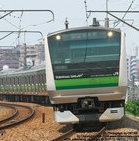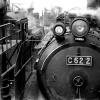Search the Community
Showing results for tags 'signals'.
-
Dear all, I recently got some Mafen N-scale signals for my layout ( https://shop.model-fab.com/en/sncf/725-04-8436579380199.html ). I find them really nice and detailed. I am wondering however if there are specific requirements in terms of current. It is written on the box 21V max but there is no mention of any amperage. I am planning on building a little circuit with 6-pin switches to activate these signals and I cannot find any specifications that would allow me to chose my power supply. I was able to find that the LEDs of these signals (which seem to be SMD 0603) have a low amperage requirement but the Mafen signals come with electrical resistances so I am guessing higher amperage may be ok... Have you ever used these signals on your layout ? Would you have any recommendation for wiring them ? Thank you !
- 11 replies
-
Dig those tunes! Almost like a New Order b-side. Really really b-side. Anywho... Following my wildly successful post a few months ago (link below), here's another British video that spent months on my 'watch later' list. This is a 1989 British Railways Board production reviewing all sorts of signalling and related infrastructure. Although this video is 27 years after the other, there are a few views of older interlocking mechanisms, pulley systems, and mechanical signals. Prior to seeing that other video, it hadn't really occurred to me that 'interlocking' truly involves a complex array of slots and levers that physically bar certain switch and signal selections. I'm also impressed with the physical signalling, not only semaphores but various smaller units such as the one in the video thumbnail. I would think there must at least a little freezing weather that would interfere with these. Amongst the many interesting topics are the overview of token safeworking (both single and multiple--I had always wondered what happens if the token winds up at the wrong end of the section) starting around 27:30, and a crossing gate meant to be operated by the public at 49:00. I love the sign (49:45) for motorists who have just crossed: Have you lowered the barriers? I can just imagine this in practice in the current US. "No, I haven't, because driving like a #%*(^!- @#%$ is my style"
-
I had this in the 'watch later' list for quite a while, finally got to it this evening. Glad I did. https://en.wikipedia.org/wiki/British_Transport_Films
- 2 replies
-
- 6
-

-
- uk
- british rail
-
(and 5 more)
Tagged with:
-
Dear experts, I have a KATO lay-out with two KATO signals, the ones that show green and after the train passed show red and after a few seconds yellow and green again. No further logic. https://res.cloudinary.com/houprk4km/image/upload/c_scale,f_auto,q_auto,w_auto/v1526054665/zwlyn3woxs6a48bidjwb.jpg I have two of these but they won't work on DCC. I am have started to convert my layout to DCC. I will be using Digikeijs controller and I/O (whatever that is called in the DCC world), controlled by iTrain software. Conversion to DCC rendered my Kato signals useless. I will also be needing a few more to improve realism. I am now looking for prototypical correct JR signals that can be connected to the DCC system. They will be hooked up and controlled by iTrain . Is anybody aware of source for N-scale JR signals with working LEDs? I am aware of Greenmax models but these are dummies. I know I could possibly fit them with SMD LEDs but it would be a rather fiddly job I was hoping to avoid. Not sure if it would be easy to convert the KATO signals and wire them up to DCC. I find the Kato model also a bit plasticky and not very refined. I noticed that JR signals are a bit like the Dutch signals, but different nevertheless. I haven't given up on real JR signals yet! Your idea's are welcome!.
-
Is there anyone who knows or can point me to where I can find info on these? Or info on what signals where used on the hakodate main line in the late 60's early 70's?

.thumb.jpg.c7e5c2d2c8b9bb9833da1dc5631a77c8.jpg)

